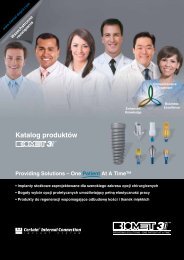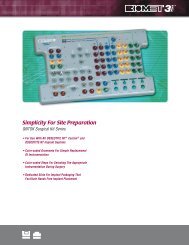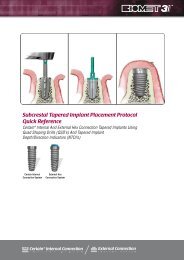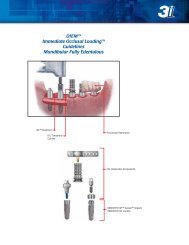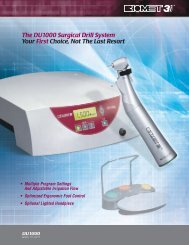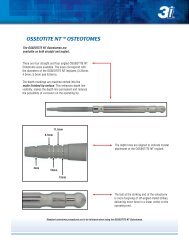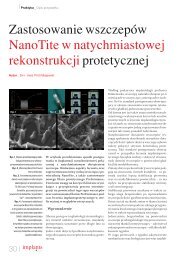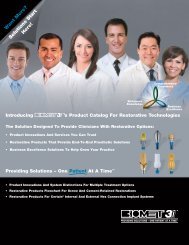SurgiGuide Cookbook - Dental-Depot
SurgiGuide Cookbook - Dental-Depot
SurgiGuide Cookbook - Dental-Depot
You also want an ePaper? Increase the reach of your titles
YUMPU automatically turns print PDFs into web optimized ePapers that Google loves.
Planning actionsTo achieve full advantage of the SAFE System, the planning phase is the keystone of theprocess. The design of implant lengths and other indications must be checked earlier, in theplanning process, in order to incorporate depth control in the design of the guide.1. Planning of implant positionIt is very important to carefully plan the position, angulation and depth of each implant. TheSimPlant Concept can be used to plan your implants in a 3D environment based on CTimages, taking into account bone quality, quantity and esthetic considerations. It is extremelyimportant that implant position and angulation as well as depth are accurately planned,because SAFE guides will incorporate the depth control for the surgical process.2. Planning of implant lengthIn order to incorporate depth control for drilling and implant placement, it is extremelyimportant to plan the implant length before manufacturing of the guides takes place. Theinformation that you provide will be used to manufacture the guides. Based on CT informationin SimPlant, the maximal length of each implant can be defined depending on the bonequantity. If allowed by the anatomy of the patient, it can be helpful to have all implants of thesame length. Doing this may result in an eased surgical phase since fewer components willbe needed to drill and place the implants.Important remark: Providing depth control in the design phase of the <strong>SurgiGuide</strong> willguarantee to have the complete diameter of the drilled hole over the complete length of theimplant to be placed. However, because of the design of the drills, the actual drill point (Yfactor)will insert slightly deeper into the bone than the actual apical point of the plannedimplant. Therefore it is critical to include a safety region around critical anatomical structures.3. Planning of implant diameterThe implant diameters should be chosen depending on the anatomy of the patient, taking intoaccount the bone crest geometry and the bone density. If no clinical and/or mechanicalcontra-indications exist, it might be useful to choose a smaller implant diameter in areas withvery dense bone, eliminating the need for implant tapping during the surgical process. Evenfor larger implant diameters, the drilling process can be performed taking full advantage of theSAFE System, though technical restrictions might prevent the possibility for the actual implantguidance.SURGICAL PROCEDURES74www.SimPlant.com<strong>SurgiGuide</strong> <strong>Cookbook</strong>



